The dollar volume of new small business commercial and industrial (C&I) loan balances declined 10.5 percent in the second quarter of 2019 compared with the second quarter of 2018, with outstanding small business C&I balances declining 0.8 percent for the same period. The decline in new small business C&I loans was driven by decreases in term loans and credit lines of 8.6 percent and 13.3 percent, respectively. Most of the 126 respondents to the Federal Reserve’s Small Business Lending Survey (FR 2028D) reported that credit quality remained largely unchanged, but indicated tightening of credit standards and loan terms. Interest rates on fixed rate term loans and variable rate lines of credit decreased, while the number of respondents reporting stronger loan demand also decreased.
Chart 1: Small Business C&I Loan Balances Decline Year-Over-Year
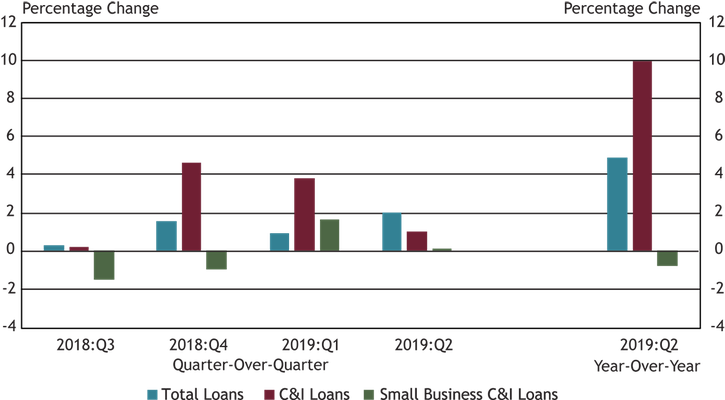
Note: Items are calculated using a subset of respondents that completed the FR 2028D for the last five quarters surveyed.
Sources: Call Report, schedule RC-C, items 4 and 12; and FR 2028D, items 4.b and 5.c.
Small business C&I loan balances remained relatively unchanged compared with the previous quarter, but decreased 0.8 percent compared with the second quarter 2018._ C&I and total loan balances grew 9.9 percent and 4.9 percent respectively, compared with the second quarter 2018.
Chart 2: Balances on Small Business C&I Loans Decrease for Large Banks
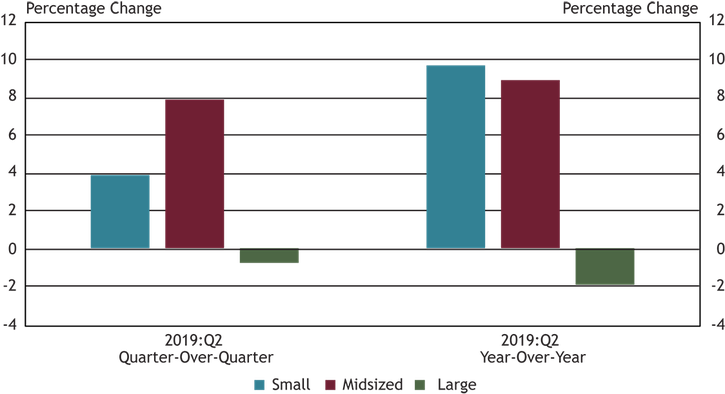
Note: Items are calculated using a subset of respondents that completed the FR 2028D for the last five quarters surveyed. Small banks have total assets of $1 billion or less, midsized banks have assets between $1 billion and $10 billion and large banks have assets greater than $10 billion.
Source: FR 2028D, items 4.b and 5.c.
Large banks reported decreases in outstanding small business C&I loan balances compared with the previous quarter and second quarter 2018, declining 0.8 percent and 1.9 percent, respectively. Compared with the previous quarter, midsized banks reported the largest increase of 8.0 percent in small business C&I loan balances. Small banks reported the largest year-over-year increase in small business C&I loan balances of 9.6 percent.
Chart 3: New Small Business C&I Loans Decline Year-Over-Year
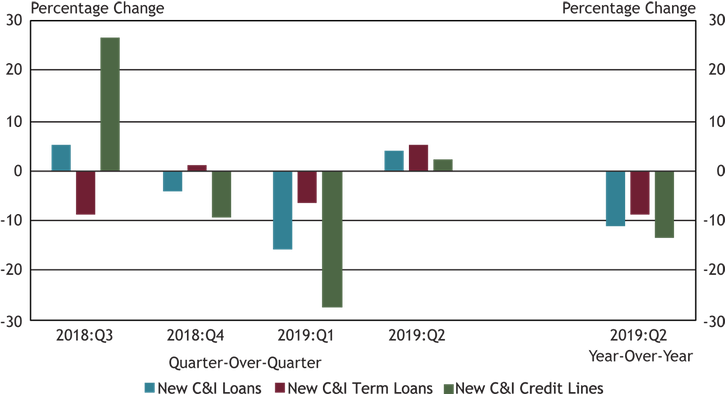
Note: Items are calculated using a subset of respondents that completed the FR 2028D for the last five quarters surveyed. All loan types referenced in Chart 3 refer to small business lending.
Source: FR 2028D, items 7.b and 10.c.
Balances of new small business C&I loans decreased 10.5 percent compared with the second quarter 2018, with new small business C&I term loans and credit lines declining 8.6 percent and 13.3 percent, respectively. The decline was the second consecutive year-over-year decrease in new small business C&I loans. Compared with the previous quarter, new small business C&I loans increased 4.4 percent, with term loans and credit lines increasing 5.5 percent and 2.6 percent, respectively.
Chart 4: Credit Line Usage Declined Slightly in the Second Quarter
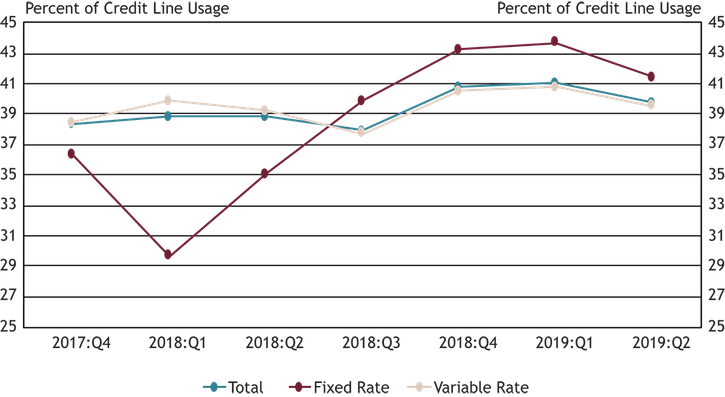
Source: FR 2028D, items 5.b and 5.c.
Total small business C&I credit line usage declined from 41.1 percent in the first quarter 2019 to 39.7 percent in the second quarter. While both fixed and variable rate credit line usage declined compared with the previous quarter, fixed rate usage declined most significantly, from 43.7 percent to 41.4 percent.
Chart 5: Interest Rates on New Fixed Rate Term Loans and Variable Rate Lines of Credit Decrease
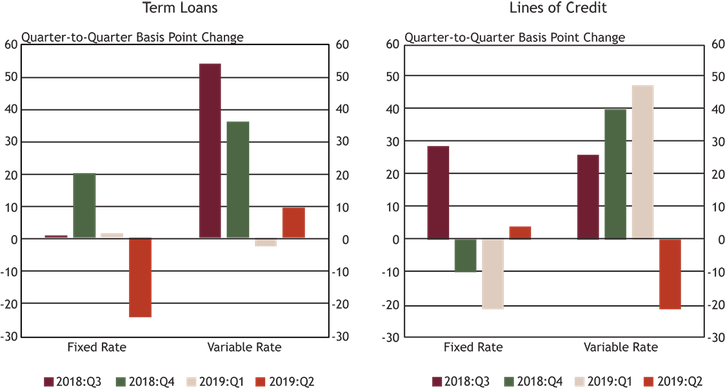
Note: Items are calculated using a subset of respondents that completed the FR 2028D for the last five quarters surveyed.
Source: FR 2028D, items 7.c and 10.d.
Weighted average rates on new C&I fixed rate term loans declined in the second quarter, decreasing 24 basis points, while variable rate term loans increased 9 basis points. Weighted average variable rate lines of credit declined by 21 basis points, while fixed rate lines of credit were up 4 basis points, increasing for the first time in three quarters.
Chart 6: Large Banks Charge Highest Rates on Fixed Rate Term Loans and Variable Rate Lines of Credit
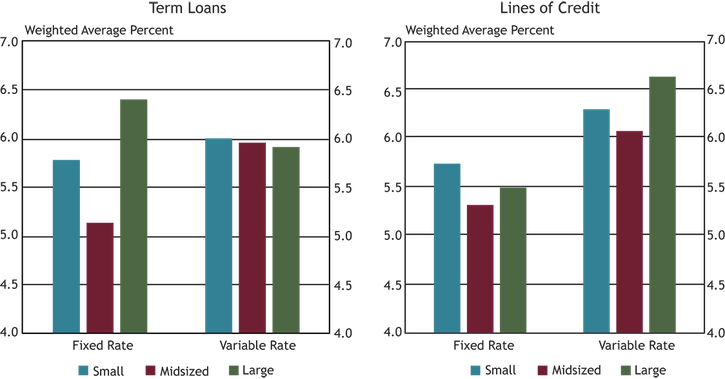
Note: Average interest rates are weighted by the dollar volume of new small business C&I loans. Small banks have total assets of $1 billion or less, midsized banks have total assets between $1 billion and $10 billion and large banks have total assets greater than $10 billion.
Source: FR 2028D, items 7.c and 10.d.
Second quarter weighted average interest rates on new small business C&I term loans and lines of credit ranged from 5.15 percent to 6.63 percent. Large banks charged the highest rates on fixed rate term loans and variable rate lines of credit, while small banks charged the highest rates on fixed rate lines of credit and on variable rate term loans.
Chart 7: Respondents Report Credit Line Usage Unchanged
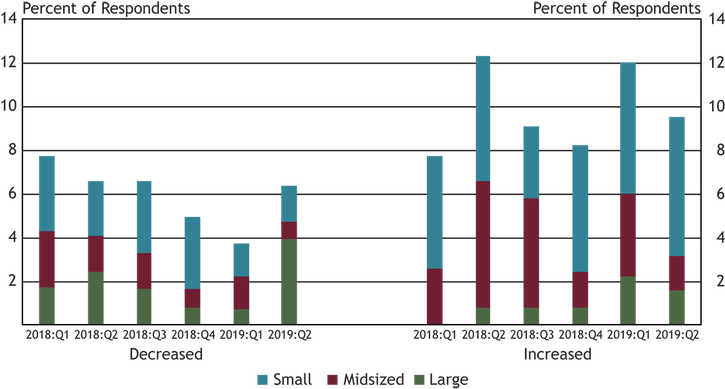
Note: Small banks have total assets of $1 billion or less, midsized banks have total assets between $1 billion and $10 billion and large banks have total assets greater than $10 billion.
Source: FR 2028D, item 11.
The percentage of respondents indicating no change in credit line usage remained at 84 percent for the second consecutive quarter. About 10 percent of respondents indicated credit line usage increased, with small banks representing the largest group reporting an increase, while about 6 percent of respondents reported a decrease. The most commonly cited reasons for a change, whether an increase or decrease, were related to borrowers’ business revenue or other business-specific conditions and differences in local or national economic conditions.
Chart 8: Fewer Respondents Report Stronger Loan Demand
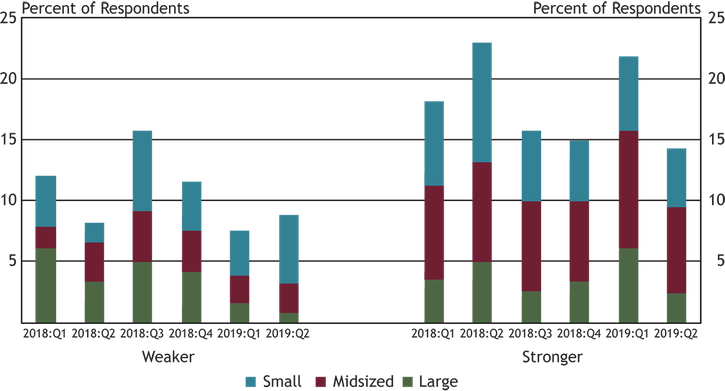
Note: Small banks have total assets of $1 billion or less, midsized banks have total assets between $1 billion and $10 billion and large banks have total assets greater than $10 billion.
Source: FR 2028D, item 13.
The number of respondents reporting stronger loan demand decreased in the second quarter, while those reporting weaker demand remained relatively unchanged. Respondents reporting stronger demand decreased across all bank sizes and declined from about 22 percent in the first quarter of 2019 to 14 percent in the second quarter. About 77 percent of respondents reported loan demand remained unchanged.
Chart 9: Small Business C&I Application Approval Rates Increase for Small and Large Banks
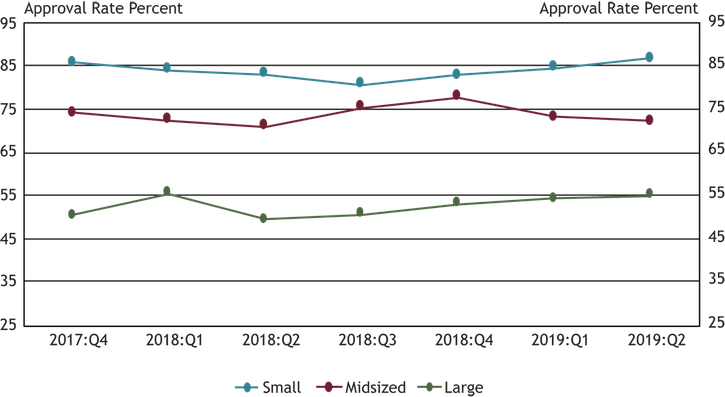
Note: Small banks have total assets of $1 billion or less, midsized banks have total assets between $1 billion and $10 billion and large banks have total assets greater than $10 billion.
Source: FR 2028D, items 14.a and 17.
Application approval rates varied from 87 percent at small banks to 55 percent at large banks during the second quarter. Application approval rates continued to trend higher for small and large banks, but decreased for midsized banks. The three most commonly cited reasons for denying a loan were borrower financials, collateral quality and credit history.
Chart 10: Credit Quality Remains Relatively Unchanged
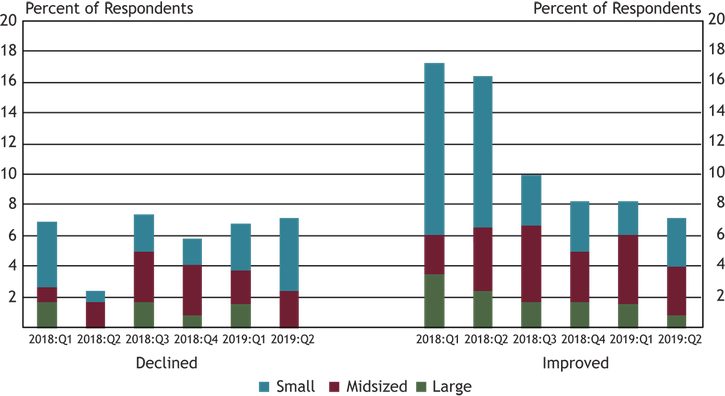
Note: Small banks have total assets of $1 billion or less, midsized banks have assets between $1 billion and $10 billion and large banks have assets greater than $10 billion.
Source: FR 2028D, items 24 and 25.
About 86 percent of respondents indicated credit quality of applicants remained unchanged in the second quarter, relatively unchanged from the previous quarter. The remaining 14 percent of respondents were evenly split between reporting improving and declining credit quality, similar to the previous quarter. The most commonly cited reasons for a change, whether improved or declined, were debt-to-income level of business owners, liquidity position of business owners, recent business income growth, and prospects for business growth or enterprise values.
Chart 11: Banks Tighten Credit Standards and Most Loan Terms
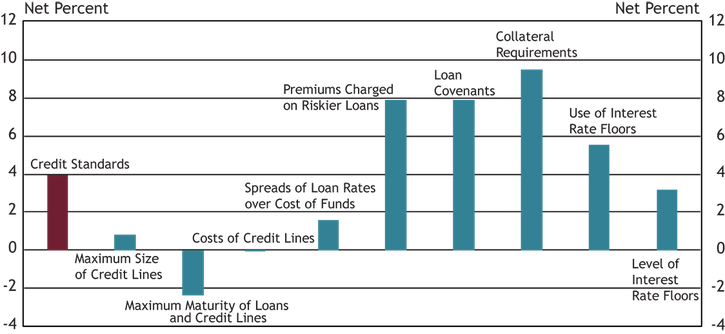
Note: The net percent refers to the percent of banks that reported having tightened (“tightened considerably” or “tightened somewhat”) minus the percent of banks that reported having eased (“eased considerably” or “eased somewhat”).
Source: FR 2028D, items 18, 19, 20 and 22.
Chart 11 shows diffusion indexes for credit standards (red bar) and various loan terms. The diffusion indexes show the difference between the percent of banks reporting tightening terms and those reporting easing terms. About 87 percent of respondents reported no change in credit standards in the second quarter, similar to the previous quarter. Of banks indicating a change in credit standards, 4 percent on net reported tightening their credit standards.
On net, respondents indicated that most loan terms tightened with collateral requirements, premiums charged on riskier loans, and loan covenants showing the most tightening. Respondents indicated that the maximum maturity of loans and credit lines was the only term to ease over the past quarter.
Of respondents reporting tightening, 87 percent cited a less favorable or more uncertain economic outlook as a somewhat or very important reason, with 69 percent citing worsening of industry-specific problems and 66 percent indicating a reduced tolerance for risk. More aggressive competition from other bank lenders was cited as a somewhat or very important reason by 78 percent of respondents reporting easing, with 54 percent indicating more aggressive competition from nonbank lenders.
*Other contributors to this report included Dan Harbour, Thomas Hobson, Brody Smith, Tony Walker, Brad Wampler and Jim Wilkinson.
Contact Us
For questions or comments about this survey, contact us at KC SRM FR2028D Survey.
Endnotes
-
1
Percentage changes in small business C&I quarterly loan totals in Chart 1 are not consistent with percentage changes in Chart 2 of the June 24, 2019, first quarter release due to respondents’ revisions to outstanding small business C&I loan totals that affect the third and fourth quarters of 2018 and the first quarter of 2019.
